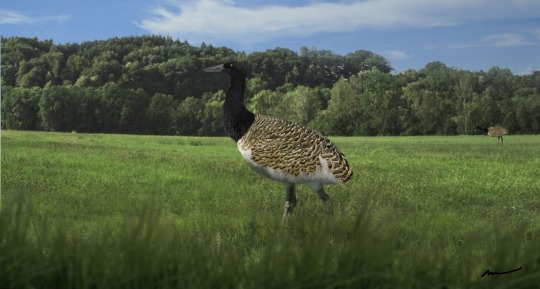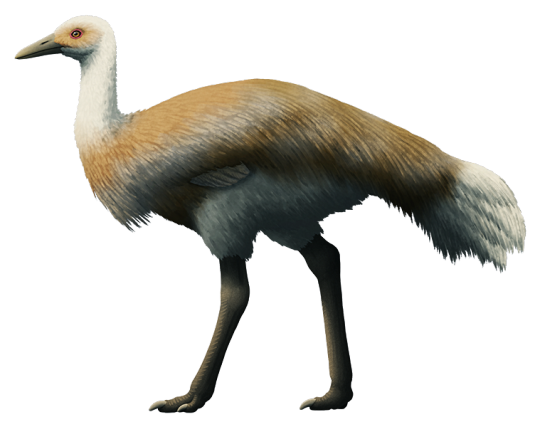#Ergilornis
Text
Fossil Novembirb: Day 16 - Among The Giants

During the Oligocene epoch, 33-23 million years ago, the landscape of Mongolia was as endlessly vast and wild as today. Forests were rare in this part of the world, instead there were shrublands, savannahs and deserts there. This landscape was the realm of giants, like the Paraceratherium of Walking With Beasts fame. Birds were also living in this land of giants, and some were already adapting to it.
Heterostrix: A small early owl, roughly the size of modern pygmy owls. But despite its small size, it was a capable predator of large insects, lizards and mammals, even birds as large as itself.
Agnopterus: One of the earliest known true flamingoes. Little is known of this bird, but it likely fed on tiny crustaceans filtered from the water, as do modern flamingoes.
Sonogrus: One of the flightless paleognath birds that was closely related to ostriches. This fleet footed herbivore belonged to the group known as paragruids.
Ergilornis: Another stem-ostrich in the group known as ergilornithids. The inner toe of these birds was reduced in size to allow for more efficient running.
Caspiodontornis: One of the few pelagornithids known from Asia, this pseudotoothed giant flew above the remnants of the ancient Tethys Sea.
#Fossil Novembirb#Novembirb#Dinovember#birblr#palaeoblr#Birds#Dinosaurs#Cenozoic Birds#Heterostrix#Agnopterus#Sonogrus#Ergilornis#Caspiodontornis
59 notes
·
View notes
Text
FOSSIL NOVEMBIRB - DAY 16
I was sick! I cannot believe I couldn't post this Ergilornis yesterday!

As always, you can get all these cute stuff in my redbubble

#Ergilornis#fossil novembirb#november prompt list#novembirb#birb art#birblr#birdblr#chibi bird#paleobird#paleoblr
30 notes
·
View notes
Text
Fossil Novembirb 16: Among the Giants

Ergilornis by Countmustard, CC BY-SA 4.0
Continuing with our half-theme of "highlighting birds that should have been present in Walking with Prehistoric Beasts episodes", here we look at the birds of the late Eocene - Oligocene of Central Asia - aka, the land of Indricotheres! While mostly remembered for the largest land mammals of all time (which, for the record, were the same size as the largest Ornithischians), this place also boasted quite a few bizarre birds!
Well, bizarre in one sense of the term, anyway. There are a handful of birds that have a mysterious classification, in that for the longest time they were thought to be in Gruiformes - rails and cranes. But, in recent studies, turns out they were Palaeognaths all along - possibly even stem-Ostriches! This would fill a gap in Ostrich evolution, as they seem to just appear fully fledged in the Neogene.

Ergilornis by @alphynix
As such, their place on the open plains of Land of Giants would have been noticeable! They had long legs are were quite large in size, and even reduced the second toe like in living ostriches, up to losing it in Neogene forms. The similarities to ostriches, once thought to be convergent, may actually be homologous - as skull material from Ergilornis, Proergilornis, and Sonogrus showcase many similarities to ostriches and other ratites. They probably would have been fast movers in their landscapes, cursorial herbivores like ostriches today.
These ratites are among the most common bird fossils in the late Paleogene of central Asia, indicating that such large cursorial birds were a major feature of the ecosystem. With multiple different species all coexisting in some localities, niche partitioning would have been involved - indicating an environment rich in potential food sources as the plains grew and grains became more plentiful.
Of course, there were other birds besides ancient ostriches! Agnopterus is another case of mistaken identity, originally thought to be possibly a species of waterfowl, but now thought to be one of the first crown-flamingos. It probably fed similarly to living flamingos, filtering small sources of food out of the water.

Caspidontornis by @drawingwithdinosaurs
Pseudo-toothed birds were there too in the form of Caspiodontornis, a poorly known species that probably fed upon the sea food in the dwindling Tethys Sea. Known from a complete skull and beak, it had ridiculously jagged teeth and would have been able to snatch a variety of slippery marine prey.
Finally, the early owl Heterostrix was the size of living pygmy owls, and fed on a variety of prey - including larger insects, lizards, small mammals, and even equally sized birds. It had very mobile second toes, allowing it to grip a variety of weirdly sized and shaped prey animals. It would have been a menace to the world of the small on the plains of Mongolia.
Sources:
Mayr, 2022. Paleogene Fossil Birds, 2nd Edition. Springer Cham.
Mayr, 2017. Avian Evolution: The Fossil Record of Birds and its Paleobiological Significance (TOPA Topics in Paleobiology). Wiley Blackwell.
#Fossil Novembirb#Novembirb#Dinovember#Dinosaurs#Birds#yeah I don't have a lot of art access for this one sorry y'all
72 notes
·
View notes